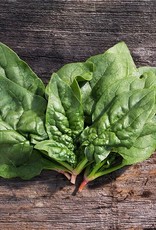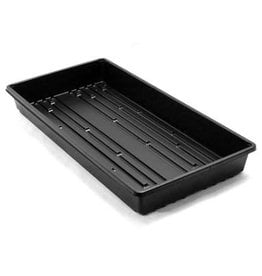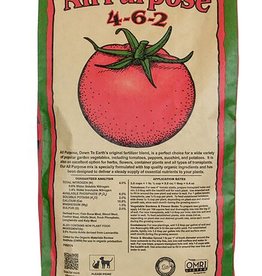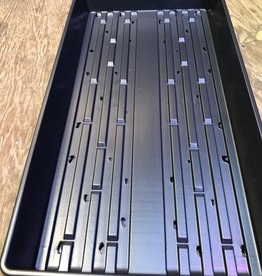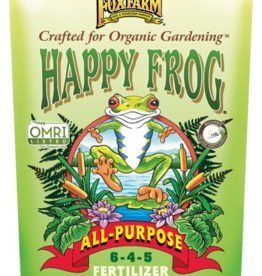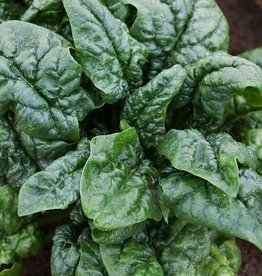HM Regiment F1 Spinach 100 SEEDS
| Availability: | In stock (32) |
Photo and Description Credit - High Mowing Seeds
Vigorous plants pack on the weight, producing healthy bunches in no time.
Very quick growing, lightly savoyed leaves with a distinctive arrowhead shape and bright-eyed medium green finish. Excellent texture and mild flavor. Works well in all seasonal slots; good resistance to bolting. From our partners at Bejo Seeds. Precision sized.
- Field/tunnel
- Spring/fall/overwinter
- Giant leaf-type
Disease Resistance Details
High Resistance: Downy Mildew (1-7, 11, 13, 15)
1,550-3750 (2,200 avg) seeds/oz, 25-60M (35M avg) seeds/lb. M= 1,000
Seeding Rate
Babyleaf- 70M seeds/100’bed (~2lb/100’bed), 700M seeds/1000’bed (~20lb/1000’ bed) using 640 seeds/ft on 3’beds (16 rows/ bed). Bunching- 1,100 seeds/100’ row (~1/2oz/100’row), 11M seeds/1,000’row (5oz/1000’row) using 10 seeds/ft, 18” row spacing.
Cultural Info
Spinach (Spinacia oleracea) is a cool-season hardy annual in the Chenopodiaceae family, which also includes beets, chard, orach and quinoa. Spinach has two leaf types.
- Smooth leaf types are easiest to wash but require more material per bag because they pack more tightly.
- Savoy types are usually darker green and offer greater heft and loft once bagged, but require more careful washing.
New hybrid spinach varieties offer increased yield, disease resistance (especially for downy mildew), adaptability, and uniformity. Older, open-pollinated varieties are generally less adaptable, but can do exceptionally well under the right conditions and many believe they taste better.
Soil Nutrients and Requirements
Like all leafy greens, spinach thrives in fertile and moist soil. Spinach is sensitive to soil pH, preferring a range of 6.5-7. Magnesium deficiency manifests in yellowing leaves similar to nitrogen deficiency. Because spinach will carry excess nitrates if over fertilized, try correcting Magnesium first.
Seeding Depth
1/8-1/4”
Plant Spacing
For babyleaf ~40seeds/ft” in 2-4” bands, for bunching 2”
Row Spacing
For babyleaf space bands 1-2” apart, for bunching 12-18”
When to Sow
Direct seed as soon as soil can be worked in the spring, and again in the late summer-early fall. Greenhouse spinach is sown in early fall to give just enough time to germinate and produce a modest amount of leaf, but not grow so fast as to require a lot of upkeep. Seed germinates best when soil temperatures are 32-60°F and achieves the best quality when air temperatures are 55-60°F. Sow every 7 days for a continual harvest.
Harvest
Harvest individual leaves or cut baby leaves 1” above the ground. Harvest the entire plant for bunched spinach by cutting the whole plant right below its crown.
Storage
Store washed spinach at low temperatures and high humidity for 10-14 days.
Pest Info
- Aphids can be washed off plants with a hard stream of water. They have several natural predators that control populations including parasites (aphids appear grey or bloated), lady beetle larvae and lacewings.
- Leafminers are generally controlled by natural predators. Deep plowing in the spring can help, as well as controlling alternate hosts such as lambsquarter, chickweed, nightshade and plantain.
Disease Info
- Spinach is susceptible to downy mildew (Peronospora farinosa f. sp. spinaciae) and fusarium wilt (Fusarium oxysporum f. sp. spinaciae).
- Fusarium wilt is primarily soil borne, but can be spread over long distances by infected seed. Use only disease-free seed. Once introduced to the soil, fusarium wilt is difficult to eradicate. Crop rotations help eliminate inoculum, and the addition of lime at 2 tons per acre also reduces disease severity by increasing pH to alkaline levels that do not favor disease development.
- Downy mildew is not as persistent and its pressure can be reduced by three-year rotations with non-host crops.
- White rust can be a problem for spinach growers, primarily in southern climes; resistant varieties are now available.
- Cucumber mosaic virus, transmitted by aphids, causes stunting and underdevelopment in plants. Larvae of the Canada leafminer burrow into leaves causing blisters, making leaves unmarketable. Control insect pressure by using row cover and controlling weed hosts.


